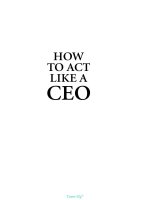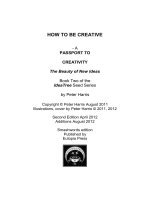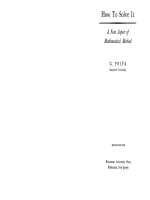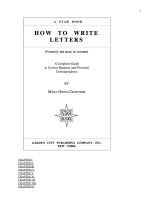how to solve it a new aspect of mathematical method pdf
Bạn đang xem bản rút gọn của tài liệu. Xem và tải ngay bản đầy đủ của tài liệu tại đây (36.52 MB, 284 trang )
How to Solve It
www.TechnicalBooksPDF.com
This page intentionally left blank
www.TechnicalBooksPDF.com
How to Solve It
A New Aspect of
Mathematical Method
G. POLYA
With a new foreword by john H. Conway
Princeton University Press
Princeton and Oxford
www.TechnicalBooksPDF.com
Copyright© 1945 by Princeton University Press
Copyright© renewed 1973 by Princeton University Press
Second Edition Copyright© 1957 by G. Polya
Second Edition Copyright © renewed 1985
by Princeton University Press
All Rights Reserved
First Princeton Paperback printing, 1971
Second printing, 1973
First Princeton Science Library Edition, 1988
Expanded Princeton Science Library Edition,
with a new foreword by John H . Conway, 2004
Library of Congress Control Number 2004100613
ISBN-13: 978-0-691-11966-3 (pbk.)
ISBN-10: 0-691-11966-X (pbk.)
British Library Cataloging-in-Publication Data is available
Printed on acid-free paper.
oo
psi. princeton.edu
Printed in the United States of America
3
5
7
9
10
8
6
4
www.TechnicalBooksPDF.com
From the Preface to the First Printing
A great discovery solves a great problem but there is a
grain of discovery in the solution of any problem. Your
problem may be modest; but if it challenges your curiosity and brings into play your inventive faculties, and if
you solve it by your own means, you may experience the
tension and enjoy the triumph of discovery. Such experiences at a susceptible age may create a taste for mental
work and leave their imprint on mind and character for
a lifetime.
Thus, a teacher of mathematics has a great opportunity. If he fills his allotted time with drilling his students
in routine operations he kills their interest, hampers
their intellectual development, and misuses his opportunity. But if he challenges the curiosity of his students
by setting them problems proportionate to their knowledge, and helps them to solve their problems with stimulating questions, he may give them a taste for, and some
means of, independent thinking.
Also a student whose college curriculum includes some
mathematics has a singular opportunity. This opportunity is lost, of course, if he regards mathematics as a
subject in which he has to earn so and so much credit
and which he should forget after the final examination
as quickly as possible. The opportunity may be lost even
if the student has some natural talent for mathematics
because he, as everybody else, must discover his talents
and tastes; he cannot know that he likes raspberry pie if
he has never tasted raspberry pie. He may manage to find
out, however, that a mathematics problem may be as
much fun as a crossword puzzle, or that vigorous mental
v
www.TechnicalBooksPDF.com
vi
From the Preface to the First Printing
work may be an exercise as desirable as a fast game of
tennis. Having tasted the pleasure in mathematics he will
not forget it easily and then there is a good chance that
mathematics will become something for him: a hobby, or
a tool of his profession, or his profession, or a great
ambition.
The author remembers the time when he was a student
himself, a somewhat ambitious student, eager to understand a little mathematics and physics. He listened to
lectures, read books, tried to take in the solutions and
facts presented, but there was a question that disturbed
him again and again: "Yes, the solution seems to work,
it appears to be correct; but how is it possible to invent
such a solution? Yes, this experiment seems to work, this
appears to be a fact; but how can people discover such
facts? And how could I invent or discover such things by
myself?" Today the author is teaching mathematics in a
university; he thinks or hopes that some of his more eager
students ask similar questions and he tries to satisfy their
curiosity. Trying to understand not only the solution of
this or that problem but also the motives and procedures
of the solution, and trying to explain these motives and
procedures to others, he was finally led to write the
present book. He hopes that it will be useful to teachers
who wish to develop their students' ability to solve problems, and to students who are keen on developing their
own abilities.
Although the present book pays special attention to the
requirements of students and teachers of mathematics, it
should interest anybody concerned with the ways and
means of invention and discovery. Such interest may be
more widespread than one would assume without reflection. The space devoted by popular newspapers and
magazines to crossword puzzles and other riddles seems
to show that people spend some time in solving unprac-
www.TechnicalBooksPDF.com
From the Preface to the First Printing
vii
tical problems. Behind the desire to solve this or that
problem that confers no material advantage, there may
be a deeper curiosity, a desire to understand the ways and
means, the motives and procedures, of solution.
The following pages are written somewhat concisely,
but as simply as possible, and are based on a long and
serious study of methods of solution. This sort of study,
called heuristic by some writers, is not in fashion nowadays but has a long past and, perhaps, some future.
Studying the methods of solving problems, we perceive
another face of mathematics. Yes, mathematics has two
faces; it is the rigorous science of Euclid but it is also
something else. Mathematics presented in the Euclidean
way appears as a systematic, deductive science; but mathematics in the making appears as an experimental, inductive science. Both aspects are as old as the science of
mathematics itself. But the second aspect is new in one
respect; mathematics "in statu nascendi," in the process
of being invented, has never before been presented in
quite this manner to the student, or to the teacher himself, or to the general public.
The subject of heuristic has manifold connections;
mathematicians, logicians, psychologists, educationalists,
even philosophers may claim various parts of it as belonging to their special domains. The author, well aware of
the possibility of criticism from opposite quarters and
keenly conscious of his limitations, has one claim to
make: he has some experience in solving problems and
in teaching mathematics on various levels.
The subject is more fully dealt with in a more extensive book by the author which is on the way to completion.
Stanford University, August
I,
I944
www.TechnicalBooksPDF.com
viii
From the Preface to the Seventh Printing
From the Preface to the Seventh Printing
I am glad to say that I have now succeeded in fulfilling,
at least in part, a promise given in the preface to the
first printing: The two volumes Induction and Analogy
in Mathematics and Patterns of Plausible Inference which
constitute my recent work Mathematics and Plausible
Reasoning continue the line of thinking begun in How
to Solve It.
Zurich, August ;o, I954
www.TechnicalBooksPDF.com
Preface to the Second Edition
ix
Preface to the Second Edition
The present second edition adds, besides a few minor
improvements, a new fourth part, "Problems, Hints,
Solutions."
As this edition was being prepared for print, a study
appeared (Educational Testing Service, Princeton, N.J.;
cf. Time, June 18, 1956) which seems to have formulated a few pertinent observations-they are not new to
the people in the know, but it was high time to formulate them for the general public-: " ... mathematics has
the dubious honor of being the least popular subject in
the curriculum . .. Future teachers pass through the
elementary schools learning to detest mathematics . . .
They return to the elementary school to teach a new
generation to detest it."
I hope that the present edition, designed for wider
diffusion, will convince some of its readers that mathematics, besides being a necessary avenue to engineering
jobs and scientific knowledge, may be fun and may also
open up a vista of mental activity on the highest level.
Zurich, june 30, zg56
This page intentionally left blank
Contents
From the Preface to the First Printing
From the Preface to the Seventh Printing
Preface to the Second Edition
v
viii
IX
"How to Solve It" list
xvi
Foreword
XIX
Introduction
XXV
PART I. IN THE CLASSROOM
Purpose
1.
Helping the student
1
2.
Questions, recommendations,
mental operations
1
3·
Generality
2
4·
5·
Common sense
Teacher and student. Imitation and practice
3
3
Main divisions, main questions
6.
Four phases
7· Understanding the problem
5
6
8.
Example
7
g.
Devising a plan
8
10.
Example
10
11.
Carrying out the plan
12
Contents
xii
Example
13· Looking back
14· Example
12.
13
14
16
15·
16.
Various approaches
The teacher's method of questioning
20
17·
Good questions and bad questions
22
19
More examples
18.
A problem of construction
19•
A problem to prove
20.
A rate problem
PART II. HOW TO SOLVE IT
A dialogue
PART III. SHORT DICTIONARY
OF HEURISTIC
Analogy
Auxiliary elements
Auxiliary problem
Bolzano
Bright idea
Can you check the result?
Can you derive the result differently?
Can you use the result?
Carrying out
33
Contents
xiii
Condition
72
Con tradictoryt
73
Corollary
73
Could you derive something useful from the data?
73
Could you restate the problem?t
75
Decomposing and recombining
75
Definition
85
Descartes
92
Determination, hope, success
93
Diagnosis
94
Did you use all the data?
95
Do you know a related problem?
98
Draw a figuret
99
Examine your guess
99
Figures
103
Generalization
108
Have you seen it before?
110
Here is a problem related to yours
and solved before
1 1o
Heuristic
112
Heuristic reasoning
113
If you cannot solve the proposed problem
114
Induction and mathematical induction
114
Inventor's paradox
121
Is it possible to satisfy the condition?
122
Leibnitz
123
Lemma
123
t
Contains only cross-references.
xxv
Contents
Look at the unknown
Modern heuristic
Notation
Pappus
123
129
134
Problems to find, problems to prove
141
148
149
154
Progress and achievement
1
Puzzles
160
Reductio ad absurdum and indirect proof
162
Redundantt
Routine problem
171
171
Rules of discovery
172
Rules of style
Rules of teaching
172
Pedantry and mastery
Practical problems
57
Separate the various parts of the condition
73
173
Setting up equations
174
Signs of progress
178
Specialization
190
Subconscious work
Symmetry
197
199
Terms, old and new
200
Test by dimension
202
The future mathematician
The intelligent problem-solver
The intelligent reader
The traditional mathematics professor
t Contains only cross-references.
1
Contents
XV
Variation of the problem
209
What is the unknown?
214
Why proofs?
215
Wisdom of proverbs
221
Working back wards
225
PART IV. PROBLEMS, HINTS,
SOLUTIONS
Problems
Hints
Solutions
HOW TO SOLVE IT
~-
UNDERSTANDING THE PROBLEM
First.
You have to understand
the problem.
What is the unknown? What are the data? What is the condition?
Is it possible to satisfy the condition? Is the condition sufficient to
determine the unknown? Or is it insufficient? Or redundant? Or
contradictory?
Draw a figure. Introduce suitable notation.
Separate the various parts of the condition. Can you write them down?
:;r:
~
DEVISING A PLAN
Second.
Find the connection between
the data and the unknown.
You may be obliged
to consider auxiliary problems
if an immediate connection
cannot be found.
You should obtain eventually
a plan of the solution.
Have you seen it before? Or have you seen the same problem in a
slightly different form?
Do you know a related problem? Do you know a theorem that could
be useful?
Look at the unknown! And try to think of a familiar problem having
the same or a similar unknown.
Here is a problem related to yours and solved before. Could you use it7
Could you use its result? Could you use its method? Should you introduce some auxiliary element in order to make its use possible?
Could you restate the problem? Could you restate it still differently?
Go back to definitions.
8"
~
1f
;::;:.
If you cannot solve the proposed problem try to solve first some related
problem. Could you imagine a more accessible related problem? A
more general problem? A more special problem? An analogous problem?
Could you solve a part of the problem? Keep only a part of the condition, drop the other part; how far is the unknown then determined,
how can it vary? Could you derive something useful from the data?
Could you think of other data appropriate to determine the unknown?
Could you change the unknown or the data, or both if necessary, so
that the new unknown and the new data are nearer to each other?
Did you use all the data? Did you use the whole condition? Have you
taken into account all essential notions involved in the problem?
~
~
0
~
CARRYING OUT THE PLAN
Third.
Carry out your plan.
<:!
"'~
Carrying out your plan of the solution, check each step. Can you see
clearly that the step is correct? Can you prove that it is correct?
LOOKING BACK
Fourth.
Examine the solution obtained.
Can you check the result? Can you check the argument?
Can you derive the result differently? Can you see it at a glance?
Can you use the result, or the method, for some other problem?
~:
This page intentionally left blank
Foreword
by John H. Conway
How to Solve It is a wonderful book! This I realized when
I first read right through it as a student many years ago, but
it has taken me a long time to appreciate just how wonderful it is. Why is that? One part of the answer is that the book
is unique. In all my years as a student and teacher, I have
never seen another that lives up to George Polya's title by
teaching you how to go about solving problems. A. H.
Schoenfeld correctly described its importance in his 1987
article "Polya, Problem Solving, and Education" in Mathematics
Magazine: "For mathematics education and the world of
problem solving it marked a line of demarcation between
two eras, problem solving before and after Polya."
It is one of the most successful mathematics books ever
written, having sold over a million copies and been translated
into seventeen languages since it first appeared in 1945.
Polya later wrote two more books about the art of doing
mathematics, Mathematics and Plausible Reasoning ( 1954) and
Mathematical Discovery (two volumes, 1962 and 1965).
The book's title makes it seem that it is directed only
toward students, but in fact it is addressed just as much to
their teachers. Indeed, as Polya remarks in his introduction,
the first part of the book takes the teacher's viewpoint more
often than the student's.
Everybody gains that way. The student who reads the book
on his own will find that overhearing Polya's comments to his
non-existent teacher can bring that desirable person into
being, as an imaginary but very helpful figure leaning over
one's shoulder. This is what happened to me, and naturally I
made heavy use of the remarks I'd found most important
when I myself started teaching a few years later.
xix
XX
Foreword
But it was some time before I read the book again, and
when I did, I suddenly realized that it was even more valuable
than I'd thought! Many of Polya's remarks that hadn't
helped me as a student now made me a better teacher of
those whose problems had differed from mine. Polya had
met many more students than I had, and had obviously
thought very hard about how to best help all of them learn
mathematics. Perhaps his most important point is that learning must be active. As he said in a lecture on teaching,
"Mathematics, you see, is not a spectator sport. To understand mathematics means to be able to do mathematics. And
what does it mean [to be] doing mathematics? In the first
place, it means to be able to solve mathematical problems."
It is often said that to teach any subject well, one has to
understand it "at least as well as one's students do." It is a
paradoxical truth that to teach mathematics well, one must
also know how to misunderstand it at least to the extent
one's students do! If a teacher's statement can be parsed in
two or more ways, it goes without saying that some students
will understand it one way and others another, with results
that can vary from the hilarious to the tragic. ]. E. Littlewood gives two amusing examples of assumptions that can
easily be made unconsciously and misleadingly. First, he
remarks that the description of the coordinate axes ("Ox
and Oy as in 2 dimensions, Ozvertical") in Lamb's book Mechanics is incorrect for him, since he always worked in an
armchair with his feet up! Then, after asking how his reader
would present the picture of a closed curve lying all on one
side of its tangent, he states that there are four main schools
(to left or right of vertical tangent, or above or below horizontal one) and that by lecturing without a figure, presuming that the curve was to the right of its vertical tangent, h e
h ad unwittingly made nonsense for the other three schools.
I know of no better remedy for such presumptions than
Polya's counsel: before trying to solve a problem, the stu-
FiJreword
XXI
dent should demonstrate his or her understanding of its
statement, preferably to a real teacher, but in lieu of that, to
an imagined one. Experienced mathematicians know that
often the hardest part of researching a problem is understanding precisely what that problem says. They often follow Polya's wise advice: "If you can't solve a problem, then
there is an easier problem you can't solve: find it."
Readers who learn from this book will also want to learn
about its author's life. 1
George Polya was born Gyorgy Polya (he dropped the
accents sometime later) on December 13, 1887, in Budapest, Hungary, to Jakab Polya and his wife, the former Anna
Deutsch. He was baptized into the Roman Catholic faith, to
which Jakab, Anna, and their three previous children,Jen6,
Ilona, and Flora, had converted fromJudaism in the previous year. Their fifth child, Laszlo, was born four years later.
Jakab had changed his surname from Pollak to the more
Hungarian-sounding Polya five years before Gyorgy was
born, believing that this might help him obtain a university
post, which he eventually did, but only shortly before his
untimely death in 1897.
At the Daniel Berzsenyi Gymnasium, Gyorgy studied
Greek, Latin, and German, in addition to Hungarian. It is
surprising to learn that there he was seemingly uninterested
in mathematics, his work in geometry deemed merely "satisfactory" compared with his "outstanding" performance in
literature, geography, and other subjects. His favorite subject, outside of literature, was biology.
H e enrolled at the University of Budapest in 1905, initially studying law, which he soon dropped because he
found it too boring. He then obtained the certification
needed to teach Latin and Hungarian at a gymnasium, a
1The following biographical information is taken from that given by
]. ]. O 'Connor and E. F. Robertson in the MacTutor History of
Mathematics Archive (www-gap.dcs.st-and.ac.uk/ -histor y/ ).
xxii
Foreword
certification that he never used but of which he remained
proud. Eventually his professor, Bernat Alexander, advised
him that to help his studies in philosophy, he should take
some mathematics and physics courses. This was how he
came to mathematics. Later, he joked that he "wasn't good
enough for physics, and was too good for philosophymathematics is in between."
In Budapest he was taught physics by Eotvos and mathematics by Fejer and was awarded a doctorate after spending
the academic year 1910-11 in Vienna, where he took some
courses by Wirtinger and Mertens. He spent much of the
next two years in Gottingen, where he met many more
mathematicians-Klein, Caratheodory, Hilbert, Runge,
Landau, Weyl, Heeke, Courant, and Toeplitz-and in 1914
visited Paris, where he became acquainted with Picard and
Hadamard and learned that Hurwitz had arranged an
appointment for him in Zurich. He accepted this position,
writing later: "I went to Zurich in order to be near Hurwitz,
and we were in close touch for about six years, from my
arrival in Zurich in 1914 to his passing [in 1919]. I was very
much impressed by him and edited his works."
Of course, the First World War took place during this
period. It initially had little effect on Polya, who had been
declared unfit for service in the Hungarian army as the
result of a soccer wound. But later when the army, more
desperately needing recruits, demanded that he return to
fight for his country, his strong pacifist views led him to
refuse. As a consequence, he was unable to visit Hungary
for many years, and in fact did not do so until 1967, fiftyfour years after he left.
In the meantime, he had taken Swiss citizenship and
married a Swiss girl, Stella Vera Weber, in 1918. Between
1918 and 1919, he published papers on a wide range of
mathematical subjects, such as series, number theory, combinatorics, voting systems, astronomy, and probability. He
Foreword
xxiii
was made an extraordinary professor at the Zurich ETH in
1920, and a few years later he and Gabor Szeg6 published
their book Aufgaben und Lehrsatze aus der Analysis ("Problems
and Theorems in Analysis"), described by G. L. Alexanderson and L. H. Lange in their obituary of Polya as "a mathematical masterpiece that assured their reputations."
That book appeared in 1925, after Polya had obtained a
Rockefeller Fellowship to work in England, where he collaborated with Hardy and Littlewood on what later became
their book Inequalities (Cambridge University Press, 1936).
He used a second Rockefeller Fellowship to visit Princeton
University in 1933, and while in the United States was invited
by H. F. Blichfeldt to visit Stanford University, which he
greatly enjoyed, and which ultimately became his home.
Polya held a professorship at Stanford from 1943 until his retirement in 1953, and it was there, in 1978, that he taught
his last course, in combinatorics; he died on September 7,
198 5, at the age of ninety-seven.
Some readers will want to know about Polya's many contributions to mathematics. Most of them relate to analysis
and are too technical to be understood by non-experts, but
a few are worth mentioning.
In probability theory, Polya is responsible for the nowstandard term "Central Limit Theorem" and for proving
that the Fourier transform of a probability measure is a
characteristic function and that a random walk on the integer lattice closes with probability 1 if and only if the dimension is at most 2.
In geometry, Polya independently re-enumerated the
seventeen plane crystallographic groups (their first enumeration, by E. S. Fedorov, having been forgotten) and together
with P. Niggli devised a notation for them.
In combinatorics, Polya's Enumeration Theorem is now
a standard way of counting configurations according to
their symmetry. It has been described by R. C. Read as "a
xxiv
Foreword
remarkable theorem in a remarkable paper, and a landmark in the history of combinatorial analysis."
How to Solve !twas written in German during Polya's time
in Zurich, which ended in 1940, when the European situation forced him to leave for the United States. Despite the
book's eventual success, four publishers rejected the
English version before Princeton University Press brought
it out in 1945· In their hands, How to Solve It rapidly
became-and continues to be-one of the most successful
mathematical books of all time.









